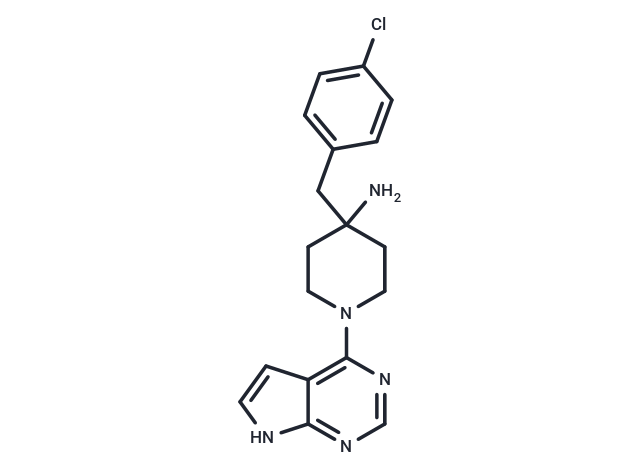Shopping Cart
- Remove All
 Your shopping cart is currently empty
Your shopping cart is currently empty

CCT128930 is a potent, ATP-competitive and selective inhibitor of Akt2 with IC50 of 6 nM, 28-fold greater selectivity for Akt2 than the closely related PKA kinase.

| Pack Size | Price | Availability | Quantity |
|---|---|---|---|
| 2 mg | $35 | In Stock | |
| 5 mg | $59 | In Stock | |
| 10 mg | $95 | In Stock | |
| 25 mg | $178 | In Stock | |
| 50 mg | $287 | In Stock | |
| 100 mg | $431 | In Stock | |
| 200 mg | $686 | In Stock | |
| 1 mL x 10 mM (in DMSO) | $65 | In Stock |
| Description | CCT128930 is a potent, ATP-competitive and selective inhibitor of Akt2 with IC50 of 6 nM, 28-fold greater selectivity for Akt2 than the closely related PKA kinase. |
| Targets&IC50 | Akt2:6 nM |
| In vitro | CCT128930 exhibits marked antiproliferative activity against PTEN-deficient human tumor cell lines including U87 mg human glioblastoma cells, LNCaP human prostate cancer cells and PC3 human prostate cancer cells with GI50 of 6.3 μM, 0.35 μM and 1.9 μM, respectively. Furthermore, CCT128930 causes a G1 arrest in PTEN-null U87 mg human glioblastoma cells and Akt pathway blockade. [1] |
| In vivo | CCT128930 at 25 mg/kg i.p. shows a marked antitumor effect in established PTEN-null U87 mg human glioblastoma xenografts with a treated:control (T/C) ratio of 48% on day 12. In HER2-positive, PIK3CA-mutant BT474 human breast cancer xenografts, CCT128930 at 40 mg/kg also produces a profound antitumor effect with complete growth arrest and a T/C ratio of 29% on day 22. CCT128930 administrated via i.v. reaches a peak concentration of 6.4 μM in plasma and is eliminated with a relatively short half-life, high volume of distribution, and rapid clearance, giving an area under the curve AUC0-∞ of 4.6 μM h. CCT128930 administrated via i.p. leads to the peak plasma drug concentration of 1.3 μM and the corresponding AUC0-∞ of 1.3 μM·h. Oral CCT128930 administration leads to the peak plasma concentration of only 0.43 μM and a correspondingly low AUC0-∞ of 0.4 μM·h. [1] |
| Kinase Assay | Kinase assays: Profiling against 50 different human kinases is carried out using 10 μM CCT128930 at an ATP concentration equivalent to the Km for each enzyme. |
| Cell Research | Cells are seeded in 96-well plates and allowed to attach for 36 hours to ensure exponential growth prior to treatment. In vitro antiproliferative activity is determined using a 96-hour SRB assay. TCA-fixed cells are stained for 30 minutes with 0.4% (wt/vol) SRB dissolved in 1% acetic acid. At the end of the staining period, SRB is removed and cultures are quickly rinsed four times with 1% acetic acid to remove unbound dye. The acetic acid is poured directly into the culture wells from a beaker. This procedure permits rinsing to be performed quickly so that desorption of protein-bound dye does not occur. Residual wash solution is removed by sharply flicking plates over a sink, which ensures the complete removal of rinsing solution. Because of the strong capillary action in 96-well plates, draining by gravity alone often fails to remove the rinse solution when plates are simply inverted. After being rinsed, the cultures are air dried until no standing moisture is visible. Bound dye is solubilized with 10 mM unbuffered Tris base (pH 10.5) for 5 minutes on a gyratory shaker. OD is read in either a UVmax microtiter plate reader or a Beckman DU-70 spectrophotometer. For maximum sensitivity, OD is measured at 564 nm. Because readings are linear with dye concentrations only below 1.8 OD units, however, suboptimal wavelengths are generally used, so that all samples in an experiment remains within the linear OD range. With most cell lines, wavelengths of approximately 490-530 nm works well for this purpose.(Only for Reference) |
| Molecular Weight | 341.84 |
| Formula | C18H20ClN5 |
| Cas No. | 885499-61-6 |
| Smiles | NC1(Cc2ccc(Cl)cc2)CCN(CC1)c1ncnc2[nH]ccc12 |
| Relative Density. | 1.39 g/cm3 |
| Storage | store at low temperature | Powder: -20°C for 3 years | In solvent: -80°C for 1 year | Shipping with blue ice. | |||||||||||||||||||||||||||||||||||
| Solubility Information | Ethanol: 6 mg/mL (17.55 mM), Sonication is recommended. H2O: <1 mg/mL DMSO: 25 mg/mL (73.13 mM), Sonication is recommended. | |||||||||||||||||||||||||||||||||||
Solution Preparation Table | ||||||||||||||||||||||||||||||||||||
Ethanol/DMSO
DMSO
| ||||||||||||||||||||||||||||||||||||

Copyright © 2015-2025 TargetMol Chemicals Inc. All Rights Reserved.